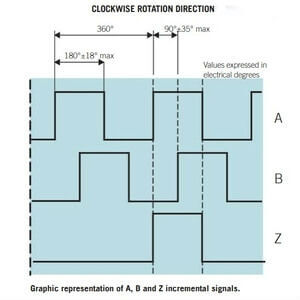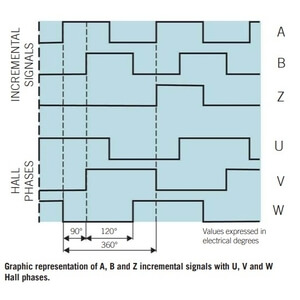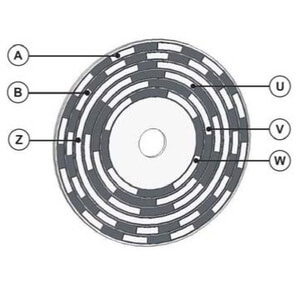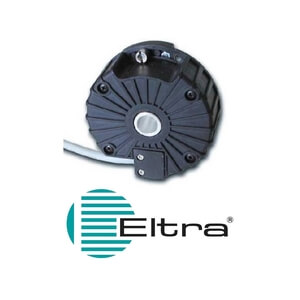21.10.2019
CONTENTS:

Incremental encoders often use three channels for outgoing signals. They are denoted as (A, B, Z). The signal comes in the form of square waves. They shifted between themselves by 90 electrical degrees.
Attention! The electrical degree is not equal to the mechanical one. An electrical degree (°e) is a parameter of phase or phase difference used in electrical engineering. It is determined by the formula: electrical 360 ° = mechanical 360 °/ (nr. pulses / turn).
Channel A provides speed information (number of pulses per unit of time).
Channel B indicates the direction of rotation (clockwise or counterclockwise).
Channel Z (zero channel) acts as a reference point.
The sensor tracks the value of the shifts between the square waves to determine the measuring results.
In addition to the main quadrature types, there are also produced encoders, which have additional integrated phases of the hall effect. Such sensors are generally used as motor feedback. They simulate Hall phase signals, which are normally generated by magnetic sensors in brushless motors. However, unlike previous one, such pulses are formed by the optical principle.
Pulses are created in the form of three quadrature waves, which are shifted between themselves not by 90, but by 120 electrical degrees.
Additional channels for these pulses are designated as:
Directly control motor driver uses them to generate the correct supply phases.
Switching signals are directly related to the number of poles in the motor. They can be repeated during single mechanical turn. For example, for a motor with 4 poles, one period will be equal to 180 electrical degrees, with 6 poles - 120°, with 8 poles -90°, etc.
The Italian company produces three series of encoders with switching signals of the Hall phases:
All sensors belong to the optical incremental encoder category. They are primarily operated in feedback systems of AC servomotors. The company produces sensors for working with a specific number of motor poles. There are three options available: 4, 6 and 8 poles (2, 3 and 4 pairs, respectively).
Let's take a closer look at them.

These are the smallest encoders of this type with an external diameter of 36 mm. Units have a mechanical connection in the form of blind hollow shaft with rear fixing. They are connected using a radial cable (standard length 0.3 m). The company additionally produces various cables with length from 2 to 10 m on demand.
Such equipment can work with motors that have 4, 6 or 8 poles. Available models with the following resolution:
In parentheses are indicated the number of motor poles. One of the main advantages of this series is full interchangeability with 15 Resolver in the motor back.
The devices use npn open collector (pull-up max + 30V DC) output type for incremental signals and the line driver RS-422 for incremental and commutation ones. Its maximum output frequency is 150 kHz.
Sensors have a robust metal housing from EN-AW-2011 aluminum and enclosure rating IP40. The producer manufactures models with bore diameter of 8, 9.52 and 10 mm. Shaft is made of 1.4305 stainless steel.
This series also includes small sensors (Ø49 mm) with blind hollow (49C) or through hollow (49P) shaft. The products have a wide resolution range from 100 to 2048 (pulse / revolution). The following resolution options are available (ppr):
Presented sensors have 6 channels to transmit outgoing signals. They use bit parallel bus for signal transmission. Equipment uses a npn open collector or line driver RS422 electrical interfaces for operations with commutation signals. For incremental signals, the line driver electrical interface (AELT-5000 or equivalent) is used.
The eltra 36 K encoders have housing from a nickel-plated brass and shaft from 1.4305 / AISI 303 stainless steel. The following bore diameters are available:
All products of the family have a protection level of IP 40 and can operate at temperatures from -20 to 85 ° C (-4 ... 185 ° F) in standard assembly or from -10 to 100 ° C (+ 14 ... + 212 ° F) in specialized versions. The total weight of the structure is 150 g.
Presented category includes incremental encoders with an external body diameter of 89 mm. The company releases versions with blind and through hollow shaft. The housing and bearing stages of the device consists of PA66 glass fiber reinforced. Models have an IP rating of 54 and can operate with temperatures up to 85 °C.
A series of encoders works with a wide range of resolutions:
Number of poles in the motor is indicated in round brackets. Products in this category use the line driver RS-422 and NPN open collector interfaces. The total weight of the assembly is 250g.
On our website eltra-encoder.eu you can find the entire range of the described products. To find out the delivery conditions and stock availability, please contact our managers.